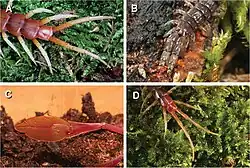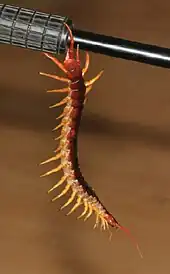Ultimate legs
Ultimate legs are a pair of modified rear legs unique to centipedes. Although they do not aid in locomotion, ultimate legs are used for a variety of uses, and their morphology varies accordingly.
| Ultimate legs | |
|---|---|
 | |
| Details | |
| Synonyms | Anal legs, caudal legs, terminal legs |
| Origins | Legs |
| Function | Varied: defensive postures, mating rituals, anchoring |
| Anatomical terminology | |
Sexual dimorphism is frequently present.[1][2][3][4]
Usage

As a defence against predators
In many species, ultimate legs are used in warning postures to scare off predators. The ultimate legs are raised, splayed, and sometimes waved back and forth.[1][2] The presence of spines on the ultimate legs of some species also serves a defensive role- as Lewis & Kronmüller (2015) put it, "a predator approaching from behind would come into contact with a battery of spines."[2]

For suspension
Some species use their ultimate legs to hang or anchor themselves from trees or other desired objects. This has been recorded as playing a role in predation; the centipede suspends itself in the air and swings back and forth to capture prey.[2]
In contact with other centipedes
.jpg.webp)
Before mating, many species of Scolopendrid centipedes interlock ultimate legs. A similar behaviour has been recorded in ordinary meetings, wherein each centipede grasps the other's trunk with its ultimate legs. This possibly serves as a way to defuse aggression, and in some species may be held for several minutes.[2]
During mating, Scutigera coleoptrata raise and lower their ultimate legs, along with their antennae.[3]
As a means of sound production
Members of the genus Alipes stridulate their leaf-like ultimate legs, probably as a way to warn off predators. The legs continue to stridulate for up to half a minute if detached from the centipede.[2]
The ultimate legs of Rhysida immarginata togoensis emit a faint creaking or squeaking sound when detached and bent.[2]
References
- Kenning, Matthes; Schendel, Vanessa; Müller, Carsten H. G.; Sombke, Andy (2019-01-14). "Comparative morphology of ultimate and walking legs in the centipede Lithobius forficatus (Myriapoda) with functional implications". Zoological Letters. 5 (1): 3. doi:10.1186/s40851-018-0115-x. ISSN 2056-306X. PMC 6330759. PMID 30656061.
- Kronmüller, Christian; Lewis, John G. J. (2015-06-30). "On the function of the ultimate legs of some Scolopendridae (Chilopoda, Scolopendromorpha)". ZooKeys. 510: 269–278. doi:10.3897/zookeys.510.8674. ISSN 1313-2970. PMC 4523778.
- Kenning, Matthes; Müller, Carsten H. G.; Sombke, Andy (2017-11-14). "The ultimate legs of Chilopoda (Myriapoda): a review on their morphological disparity and functional variability". PeerJ. 5: e4023. doi:10.7717/peerj.4023. ISSN 2167-8359. PMC 5691793.
- Sombke, Andy; Müller, Carsten H. G. (Apr 2021). "When SEM becomes a deceptive tool of analysis: the unexpected discovery of epidermal glands with stalked ducts on the ultimate legs of geophilomorph centipedes". Frontiers in Zoology. 18 (1): 17. doi:10.1186/s12983-021-00402-3. ISSN 1742-9994. PMC 8056527. PMID 33879192.